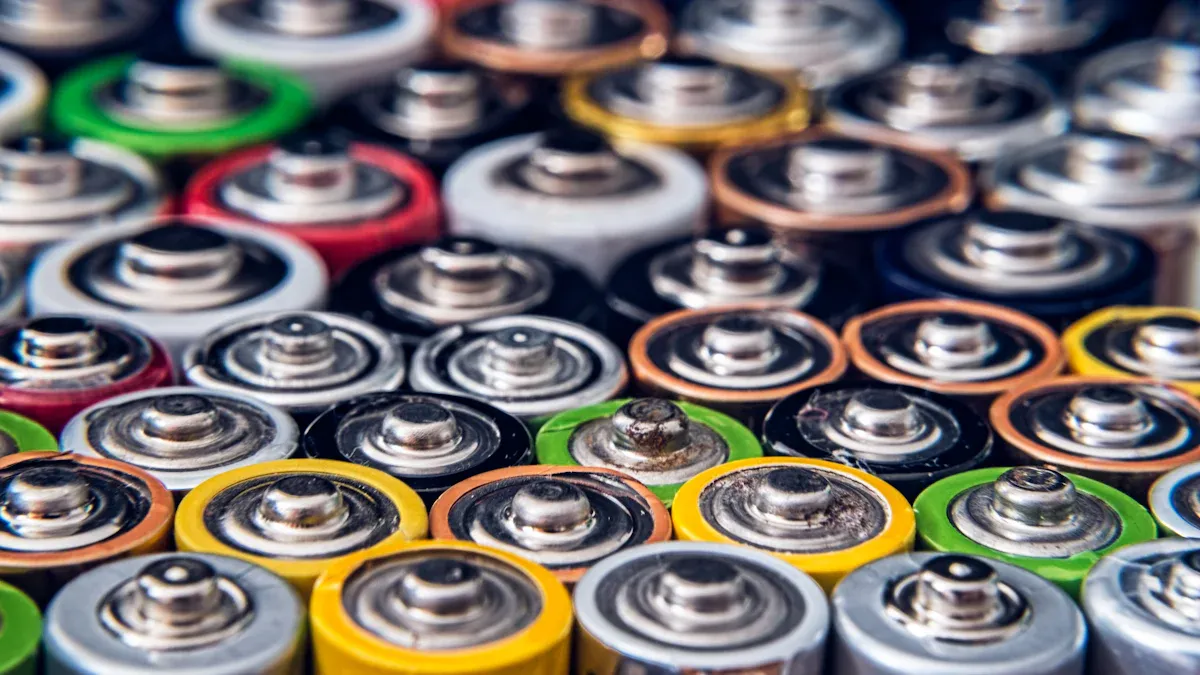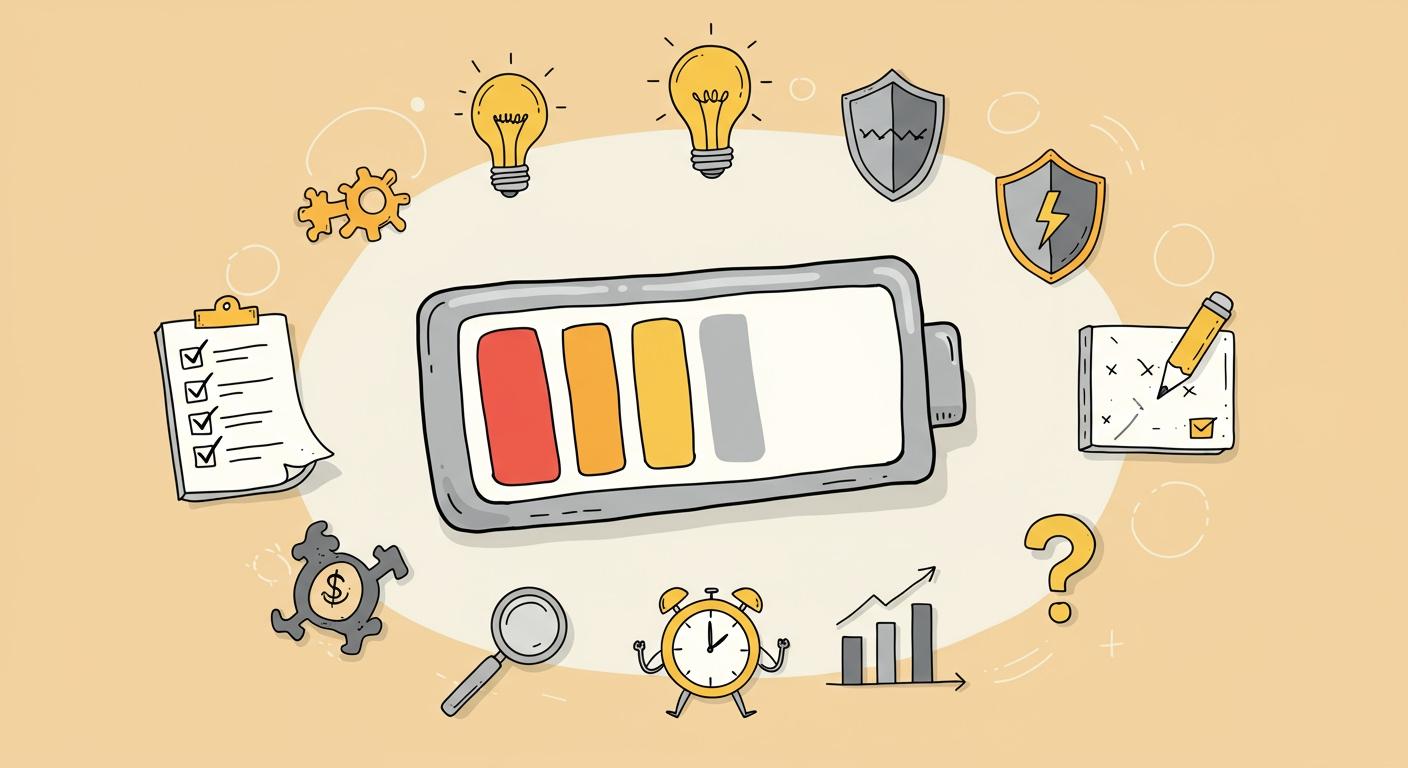7 Tips to Avoid Misunderstandings of Lithium-Ion Battery Life
You want to get the most out of your lithium-ion battery, but common misconceptions can lead to mistakes. Many people still follow outdated advice, believing myths passed down over the years. The table below shows some of the most common misconceptions about battery life and lithium-ion technology:
| Myth | Truth |
|---|---|
| You must always fully discharge the battery before recharging it. | It's not necessary to fully discharge lithium-ion batteries; they last longer if charged before complete discharge. |
| You must not charge the battery overnight, otherwise it will be damaged. | Modern chargers stop charging when full, making overnight charging safe. |
| It's better to always fully charge the battery rather than only partially charge it. | Regular partial charging is better; always fully charging can strain the battery. |
By understanding the real science behind lithium-ion batteries, you help protect your devices and support eco-friendly, environmentally friendly habits. Challenge what you know about misunderstandings of lithium ion battery life and make smarter choices.
Key Takeaways
- Charge your lithium-ion battery between 20% and 80% for optimal lifespan. This practice reduces wear and keeps your device running smoothly.
- Frequent top-ups are beneficial. You can charge your device whenever you need power without worrying about harming the battery.
- Modern chargers prevent overcharging. It is safe to leave your device plugged in overnight, as they stop charging when full.
- Store your battery at about 50% charge in a cool, dry place. This helps maintain battery health and prevents capacity loss.
- Understand the State of Health (SOH) of your battery. Regularly check it to monitor performance, but don’t panic if it drops; focus on how your device operates.
Overcharging Myths

Modern Charging Systems
Many people still believe the myths about overcharging lithium-ion batteries. You might worry that leaving your device plugged in overnight will damage the battery. This concern made sense with older battery types, but lithium-ion technology has changed the game. Modern charging systems use advanced safety features to protect your battery.
Here is a quick look at how these systems keep your battery safe:
| Safety Feature | Description |
|---|---|
| Overcharge Protection | Prevents the battery from exceeding its voltage limit, ensuring safe charging. |
| Short Circuit Protection | Protects the battery from damage due to short circuits. |
| Temperature Control | Monitors and regulates the battery temperature to prevent overheating. |
For example, the RS PRO 18650 lithium-ion rechargeable battery includes built-in PCB protection. This feature regulates voltage and stops charging if the voltage goes above 4.25V or drops below 2.5V. Devices like LED torches use these batteries because they need reliable, safe power. You can see that overcharging is no longer a big risk in most consumer electronics.
Safe Charging Habits
You can help your battery last longer by following a few simple habits. Manufacturer guidelines for charging lithium-ion batteries recommend:
- Keep the battery charged between 20% and 80% for daily use.
- Top up the battery whenever you can, instead of letting it drain completely.
- If you plan to store your device for a long time, charge the battery fully and disconnect the negative terminal.
These habits help prevent stress on the battery and extend its usable life. By understanding the real facts and ignoring old myths, you protect your devices and get the most out of lithium-ion batteries.
Full Discharge Beliefs
Partial Charging Benefits
Many people still believe that you should let your battery drain completely before charging it again. This idea comes from older battery types, not from lithium-ion technology. Today, you do not need to wait for your device to reach zero before plugging it in. In fact, you help your battery last longer by charging it before it gets too low.
- Regular partial charges put less stress on lithium-ion batteries.
- Waiting for a full discharge can cause extra wear and shorten battery life.
- Occasional full discharges are not harmful, but you should not make it a habit.
You can see that modern batteries work best when you keep them charged between 20% and 80%. This range helps reduce wear and keeps your device running smoothly. Charging your device when it drops to 30% or 40% is a smart habit. You do not need to worry about damaging your battery by topping it up during the day.
Tip: Try to avoid letting your battery drop below 20% too often. This simple step can help extend its lifespan.
Charging Lithium-Ion Batteries
Charging lithium-ion batteries to 100% every time may seem like a good idea, but it can actually increase wear. Keeping the charge level a bit lower helps your battery last longer. The table below shows how different charging habits affect battery lifespan:
| Charging Level | Impact on Battery Lifespan |
|---|---|
| 100% | Increased wear on battery |
| 80% | Prolonged lifespan |
You get the best results by unplugging your device when it reaches about 80%. This practice supports the health of your battery and helps you avoid common mistakes. By understanding how lithium-ion batteries work, you can make better choices and enjoy longer-lasting devices.
Frequent Charging Misunderstandings
Regular Top-Ups
You may have heard that charging your device too often can harm the battery. This idea comes from older battery types, not from lithium-ion technology. With lithium-ion batteries, regular top-ups actually help maintain a long cycle life. You do not need to wait until your battery is almost empty before plugging it in. Charging lithium-ion batteries when the level drops to 40% or 50% supports a healthy cycle and reduces stress.
Note: You can safely plug in your device whenever you need extra power. Frequent charging does not shorten the lifespan of lithium-ion batteries. Instead, it helps you avoid deep discharges, which can wear out the battery faster.
Many devices today use smart charging systems. These systems monitor battery health and prevent overcharging. You get better performance and a longer lifespan by topping up your battery throughout the day.
Battery Longevity
You want your battery to last as long as possible. The way you charge your device plays a big role in its lifespan. Lithium-ion batteries have a long cycle life, which means they can handle many charge and discharge cycles before losing capacity. If you keep your battery between 20% and 80%, you help preserve its long cycle life.
Here is a simple table to show how charging habits affect battery longevity:
| Charging Habit | Effect on Lifespan |
|---|---|
| Frequent top-ups | Extends lifespan |
| Deep discharges | Shortens lifespan |
| Always charging to 100% | Can reduce lifespan |
You can maximize battery longevity by avoiding deep discharges and not always charging to full. This approach helps you get the most out of lithium-ion technology. If you follow these tips, you support a healthy cycle and enjoy reliable power for your devices.
Tip: Try to keep your battery level in the middle range. This simple habit can make a big difference in how long your battery lasts.
If you have questions about battery care, explore more articles or leave a comment below. Your feedback helps us improve and share better tips for everyone.
SOH vs. Usable Life
Understanding SOH
You may see the term State of Health (SOH) when checking battery health on your device. SOH measures how much capacity your battery has compared to when it was new. For example, if your battery started with 100% capacity and now holds 80%, the SOH is 80%. This number helps you understand how much energy your battery can store.
SOH does not tell you if your battery is still usable. Many lithium-ion batteries work well even when SOH drops below 80%. You can still use your device for most tasks. SOH gives you a snapshot of battery health, but it does not mean your battery will stop working soon.
Tip: Check SOH regularly to track battery health, but do not panic if the number drops. Focus on how your device performs in daily use.
Real Battery Capacity
You might wonder what real battery capacity means for you. Real capacity is the amount of charge your battery can hold right now, not just the SOH percentage. Sometimes, a battery with lower SOH still powers your device for hours. You should look at how long your device lasts between charges, not just the SOH number.
Here is a simple table to help you compare SOH and usable life:
| SOH (%) | Usable Life | What You Should Do |
|---|---|---|
| 90-100 | Excellent | Use as normal |
| 70-89 | Good | Monitor battery health |
| 50-69 | Fair | Consider replacement |
| Below 50 | Poor | Replace soon |
You can extend usable life by following good charging habits and keeping your device cool. Lithium-ion technology helps batteries last longer, but you need to pay attention to battery health and performance.
Note: If your device shuts down quickly or charges very slowly, it may be time to replace the battery, even if SOH looks fine.
You can make smart choices by understanding SOH and real battery capacity. This knowledge helps you get the most from lithium-ion batteries and avoid common mistakes.
Battery Chemistry Myths
Cobalt Content
You may have heard that all lithium-ion batteries contain cobalt, which raises concerns about safety and environmental impact. This is one of the most common myths in battery technology. In reality, not every battery uses cobalt. Some types, like lithium iron phosphate (LFP) batteries, do not contain cobalt at all. LFP batteries stand out as one of the safest and most reliable options available. They offer a lower toxicity profile and are more environmentally friendly than other chemistries. Many manufacturers now prefer LFP batteries for these reasons.
Tip: If you want a safer and greener battery, look for devices that use LFP technology.
Many people also believe that fast charging always damages batteries. However, charging speed depends on the charger and the manufacturer's design. Modern battery technology allows lithium-ion batteries to handle different charging speeds without significant harm.
Here is a table that clears up some common myths about battery chemistry:
| Myth | Clarification |
|---|---|
| Fast Charging Can Degrade the Battery | Charging speed depends on the charger and manufacturer's specifications; lithium-ion batteries can handle various charging speeds without significant degradation. |
| Batteries Must Be Fully Charged Before Use | Lithium-ion batteries can be charged anytime without affecting lifespan; it's better to charge before use. |
| Partial Discharges Will Lead to a Memory Effect | Memory effect is not an issue for lithium-ion batteries; they are designed to avoid this problem. |
| Leaving the Battery Hooked Up to the Charger Will Reduce Its Life | Lithium-ion chargers stop charging once the battery is full, so leaving them plugged in does not harm the battery. |
Types of Lithium-Ion Batteries
You will find several types of lithium-ion batteries in modern devices. Each type has unique strengths. LFP batteries, for example, offer excellent safety and long cycle life. Nickel manganese cobalt (NMC) batteries provide high energy density, making them popular in electric vehicles. Nickel cobalt aluminum (NCA) batteries also deliver high performance for demanding applications.
When you compare battery technology, you should consider environmental impact and recyclability. Recent advances in recycling make lithium-ion batteries more eco-friendly than ever. The table below shows how lithium-ion batteries compare to other types:
| Aspect | Lithium-Ion Batteries (LIBs) | Other Battery Types |
|---|---|---|
| Energy-to-Volume Ratio | Higher | Lower (e.g., NiMH) |
| Environmental Impact | Potentially lower with eco-innovations | Varies widely |
| Recyclability | Advancements in recycling processes | Often less efficient |
You can see that battery technology continues to improve. By understanding the facts, you avoid falling for myths and make smarter choices for your devices and the environment.
Have questions about battery chemistry or want to share your experience? Leave a comment below and join the conversation!
Storage and Temperature

Storing Lithium-Ion Batteries
You want your battery to last as long as possible. Proper storage plays a big role in keeping lithium-ion batteries healthy. Manufacturers recommend storing batteries in a dry, cool place. High humidity or heat can cause capacity loss and shorten battery life. You should avoid exposing your battery to extreme temperatures. Even if you do not use your device often, regular charging helps maintain battery health.
If you plan to store your battery for more than six months, follow these best practices:
- Charge the battery to about 50% before storage.
- Do not fully charge or fully discharge the battery.
- Power down your device to reduce battery usage.
- Keep the device in a cool, dry environment below 90° F (32° C).
- Recharge the battery to 50% every six months if you store it for longer periods.
These steps help prevent capacity loss and keep your battery ready for use. You protect your investment and avoid common mistakes by following these guidelines.
Tip: Store your battery in a drawer or cabinet away from direct sunlight. This simple habit can make a big difference in battery life.
Temperature Effects
Temperature affects how well lithium-ion batteries perform. Extreme heat can speed up chemical reactions inside the battery, causing faster wear and reducing lifespan. Cold temperatures slow down these reactions, which can lower performance but usually do not cause permanent damage.
Here is a table that shows how temperature impacts battery health:
| Temperature Range | Effect on Battery Life |
|---|---|
| Below 32° F (0° C) | Reduced performance |
| 32° F - 90° F (0° C - 32° C) | Optimal range |
| Above 90° F (32° C) | Increased capacity loss |
You should keep your device within the optimal temperature range whenever possible. Avoid leaving your battery in a hot car or near heaters. If you use your device in cold weather, expect shorter run times, but normal performance will return when the battery warms up.
Note: Temperature control is one of the easiest ways to extend the life of lithium-ion batteries. You can make a big impact with small changes in how you store and use your devices.
If you have questions about battery storage or temperature, share your experience in the comments. Your feedback helps others learn and improve their battery care habits.
You now understand how correcting misunderstandings of lithium ion battery life can help you avoid common misconceptions and extend the performance of your lithium-ion battery. By following these seven tips, you protect your devices and support eco-friendly, environmentally friendly habits. Many outreach programs, such as e-waste collection points and retailer recycling, show that you can make a difference. You help reduce misconceptions and promote better care for lithium-ion batteries when you share these insights with others.
- Saudi Arabia has launched e-waste collection points.
- Awareness campaigns encourage proper battery disposal.
- Retailers offer recycling programs for old batteries.
Share your experiences and help others avoid misunderstandings of lithium ion battery life. Your actions support a cleaner, eco-friendly future.
FAQ
How often should you charge your lithium-ion battery?
You can charge your battery whenever you need power. Frequent top-ups help maintain battery health. You do not need to wait for the battery to drop to a low percentage.
Is it safe to leave your device plugged in overnight?
Yes, it is safe. Modern devices stop charging automatically when the battery is full. You do not need to worry about overcharging or damaging your battery.
What is the best way to store a lithium-ion battery?
Store your battery at about 50% charge in a cool, dry place. Avoid extreme temperatures. Check and recharge the battery every six months if you store it for a long time.
Does fast charging damage lithium-ion batteries?
Fast charging does not harm your battery if you use the charger that comes with your device. Manufacturers design batteries to handle different charging speeds safely.
How do you know when to replace your lithium-ion battery?
If your device loses charge quickly or shuts down unexpectedly, consider replacing the battery. You can also check the State of Health (SOH) in your device settings for more details.
-

 May.2025.11.24Ternary Lithium Battery vs Lithium-ion: Complete Comparison Guide (2025 Edition)Learn More
May.2025.11.24Ternary Lithium Battery vs Lithium-ion: Complete Comparison Guide (2025 Edition)Learn More -

 May.2025.11.214S2P 18650 14.8V Battery: Complete Technical Guide, Specs, Applications & SafetyLearn More
May.2025.11.214S2P 18650 14.8V Battery: Complete Technical Guide, Specs, Applications & SafetyLearn More -

 May.2025.11.18PCM vs BMS in Lithium Batteries: What’s the Difference and Which One Do You Need?Learn More
May.2025.11.18PCM vs BMS in Lithium Batteries: What’s the Difference and Which One Do You Need?Learn More -

 May.2025.11.17Custom Li-ion Battery Design for Medical Devices (2025 Comprehensive Guide)Learn More
May.2025.11.17Custom Li-ion Battery Design for Medical Devices (2025 Comprehensive Guide)Learn More -

 May.2025.11.17The Future of Lithium-Ion Batteries: Innovation, Sustainability, and Global Market TrendsLearn More
May.2025.11.17The Future of Lithium-Ion Batteries: Innovation, Sustainability, and Global Market TrendsLearn More
















